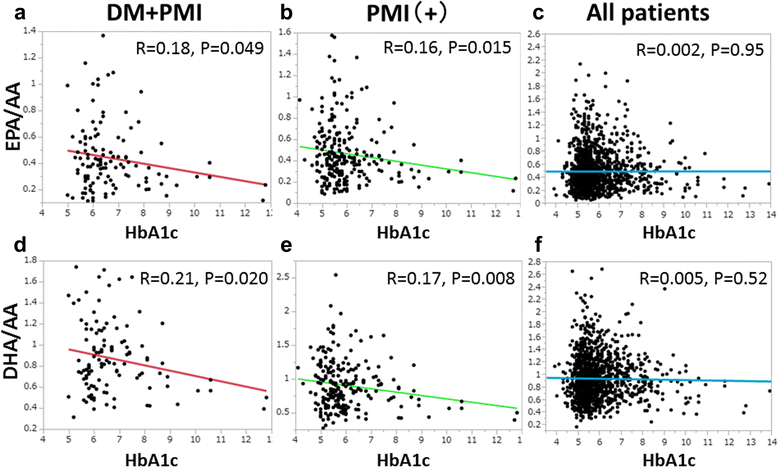The ratio of serum n-3 to n-6 polyunsaturated fatty acids is associated with diabetes mellitus in patients with prior myocardial infarction: a multicenter cross-sectional study
- PMID: 28125968
- PMCID: PMC5270364
- DOI: 10.1186/s12872-017-0479-4
The ratio of serum n-3 to n-6 polyunsaturated fatty acids is associated with diabetes mellitus in patients with prior myocardial infarction: a multicenter cross-sectional study
Abstract
Background: In prior myocardial infarction (PMI) patients, diabetes mellitus (DM), dyslipidemia, and hypertension increase the risk of secondary cardiovascular events. Although a decreased ratio of serum eicosapentaenoic acid (EPA) to arachidonic acid (AA; EPA/AA) has been shown to significantly correlate with the onset of acute coronary syndrome, the associations between polyunsaturated fatty acid (PUFA) levels and coronary risk factors in PMI patients have not been evaluated thoroughly. This study aimed to assess the associations between PUFAs levels and the risk factors in PMI patients.
Methods: We enrolled 1733 patients with known PUFA levels who were treated in five divisions of cardiology in a metropolitan area of Japan, including 303 patients with PMI. EPA/AA and docosahexaenoic acid (DHA) to AA level ratio (DHA/AA) in patients with and without PMI were analyzed according to presence of coronary risk factors.
Results: Diabetes patients with PMI had significantly lower EPA/AA and DHA/AA than diabetes patients without PMI (EPA/AA: P <0.01; DHA/AA: P =0.003), with no such differences in dyslipidemia and hypertension patients. In DM patients with high high-sensitivity C-reactive protein (hs-CRP) levels (>0.1 mg/dL), EPA/AA was low in individuals who also had PMI, whereas DHA/AA was not (EPA/AA, with PMI: 0.43 ± 0.24; without PMI: 0.53 ± 0.30, P < 0.05). Moreover, patients on statins had significantly lower DHA/AA ratios, whereas the EPA/AA ratio did not depend on statin use. Multiple regression analysis revealed that statin use in DM patients was associated with low DHA/AA but not EPA/AA.
Conclusion: PMI patients with DM have low EPA/AA and DHA/AA. EPA/AA and DHA/AA are differently related to hs-CRP level in DM patients with PMI. Statin use can potentially affect DHA/AA but not EPA/AA, and therefore EPA/AA ratio is a better marker of assessment for cardiovascular events.
Keywords: Diabetes mellitus (DM); Eicosapentaenoic acid (EPA); High-sensitivity C-reactive protein (hs-CRP); Inflammation; Polyunsaturated fatty acids (PUFAs); Prior myocardial infarction (PMI); Statin.
Figures



References
-
- Armstrong PW, Fu Y, Chang WC, Topol EJ, Granger CB, Betriu A, Van de Werf F, Lee KL, Califf RM. Acute coronary syndromes in the GUSTO-IIb trial: prognostic insights and impact of recurrent ischemia. The GUSTO-IIb Investigators. Circulation. 1998;98(18):1860–1868. doi: 10.1161/01.CIR.98.18.1860. - DOI - PubMed
-
- Dietary supplementation with n-3 polyunsaturated fatty acids and vitamin E after myocardial infarction: results of the GISSI-Prevenzione trial. Gruppo Italiano per lo Studio della Sopravvivenza nell’Infarto miocardico. Lancet. 1999;354(9177):447–55. - PubMed
-
- Matsuzaki M, Yokoyama M, Saito Y, Origasa H, Ishikawa Y, Oikawa S, Sasaki J, Hishida H, Itakura H, Kita T, et al. Incremental effects of eicosapentaenoic acid on cardiovascular events in statin-treated patients with coronary artery disease. Circ J. 2009;73(7):1283–1290. doi: 10.1253/circj.CJ-08-1197. - DOI - PubMed
-
- Lemaitre RN, King IB, Mozaffarian D, Kuller LH, Tracy RP, Siscovick DS. n-3 polyunsaturated fatty acids, fatal ischemic heart disease, and nonfatal myocardial infarction in older adults: the Cardiovascular Health Study. Am J Clin Nutr. 2003;77(2):319–325. - PubMed
Publication types
MeSH terms
Substances
LinkOut - more resources
Full Text Sources
Other Literature Sources
Medical
Research Materials
Miscellaneous

